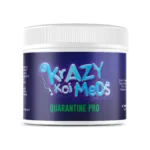Fish health is one of the most important aspects of maintaining a balanced aquarium or pond. Among the common bacterial infections that affect fish, fin rot is one of the most noticeable and potentially dangerous conditions. It often starts with fraying or discoloration of the fins and, if untreated, can progress to more severe infections that impact the overall health of the fish.
One of the most effective antibiotics used by aquarists and fish keepers is doxycycline. Known for its broad-spectrum antibacterial properties, doxycycline has been widely used to combat bacterial diseases in both freshwater and saltwater fish. In this guide, we’ll explore what fin rot is, how doxycycline works, proper usage, dosage considerations, and prevention methods to help ensure your fish live long, healthy lives.
What is Fin Rot?
Fin rot is a bacterial infection that commonly affects fish in aquariums and ponds. It is often caused by poor water conditions, stress, overcrowding, or injury, which weakens the immune system and allows harmful bacteria to take hold.
Symptoms of Fin Rot:
- Frayed or ragged fins
- White or red edges around the fins
- Inflammation at the base of fins
- Loss of fin tissue over time
- Lethargy or reduced activity
If left untreated, fin rot can spread deeper into the body, leading to systemic infections that may eventually kill the fish.
How Doxycycline Helps with Fin Rot
Doxycycline is an antibiotic that belongs to the tetracycline class. It works by inhibiting protein synthesis in bacteria, effectively stopping the growth and spread of harmful organisms that cause fin rot. Unlike some antibiotics that target only specific types of bacteria, doxycycline is broad-spectrum, making it effective against a wide range of bacterial strains commonly found in aquariums and ponds.
Benefits of Using Doxycycline:
- Effective against gram-negative and gram-positive bacteria
- Works in both freshwater and saltwater environments
- Reduces inflammation and secondary infections
- Safe for most ornamental fish when dosed correctly
Correct Usage and Dosage of Doxycycline
When treating fin rot with doxycycline, it’s crucial to follow proper dosage and administration guidelines. Incorrect use can harm fish or lead to antibiotic resistance.
General Guidelines:
- Quarantine tank: Always treat fish in a separate hospital tank to avoid disrupting beneficial bacteria in your main aquarium.
- Dosage: Carefully measure according to tank size and follow the specific product instructions.
- Treatment cycle: Typically ranges from 5–10 days, depending on severity.
- Water quality: Ensure ammonia, nitrite, and nitrate levels are controlled to help recovery.
- Observation: Monitor fish closely for improvement in fin condition and activity levels.
Prevention of Fin Rot
While doxycycline is highly effective, prevention is always better than treatment. Keeping your aquarium or pond environment healthy reduces the risk of fin rot outbreaks.
Preventive Measures:
- Maintain clean water with regular water changes
- Avoid overcrowding tanks
- Provide a balanced diet with essential nutrients
- Quarantine new fish before introducing them
- Minimize stress by maintaining stable water temperature and pH
Final Thoughts
Fin rot can quickly become a serious problem for aquarium and pond fish if left untreated. Fortunately, doxycycline offers an effective way to combat this bacterial infection, helping fish recover and return to full health. When combined with good aquarium practices, clean water, and preventive care, fish keepers can minimize the risk of recurring infections.
By understanding the causes of fin rot and how antibiotics like doxycycline work, you can ensure your aquatic pets thrive in a healthy, stress-free environment.
FAQs About Doxycycline and Fin Rot
Q1: Can doxycycline cure fin rot completely?
Yes, when administered correctly, doxycycline can effectively stop the bacteria causing fin rot and allow fins to regenerate.
Q2: How long does it take for fish to recover?
Most fish show improvement within 5–7 days of treatment, but full fin regrowth may take several weeks.
Q3: Can I use doxycycline in my main tank?
It’s best to treat fish in a hospital or quarantine tank, as antibiotics can disrupt the biological balance of your main aquarium.
Q4: Is doxycycline safe for all types of fish?
Most ornamental fish tolerate doxycycline well, but always check dosing guidelines for specific species.
Q5: How do I prevent antibiotic resistance in fish?
Always complete the full treatment course, avoid underdosing, and practice good aquarium management to minimize repeat infections.

